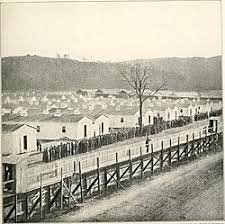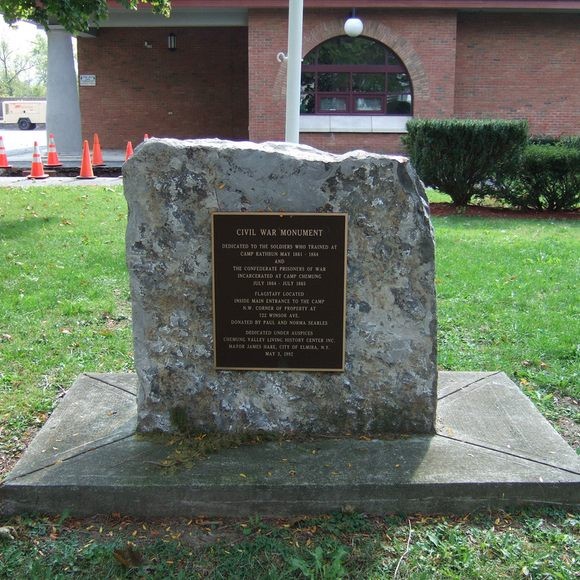Camp Elmira Monument
Introduction
Text-to-speech Audio
Elmira, New York, was once the site of one of the Civil War’s most notorious prison camps. Now a suburban neighborhood, only a few historic markers identify the site as the location of Camp Elmira, where nearly 3,000 Confederate prisoners of war died. The camp was in operation only a short time, from July of 1864, through the summer of 1865. During that time, the squalid conditions and high mortality rate would earn the prison the grim moniker, “Hellmira.”
Images
Camp Elmira during the Civil War

A monument on the site of Camp Elmira

Graves of the Confederate soldiers who died at Camp Elmira and were interred at Woodlawn Cemetery

Backstory and Context
Text-to-speech Audio
Originally known as Camp Rathbun, the fort that would become one of the North’s most horrific Confederate prisons began as a Union training post. The fort served as a training ground for several years before falling into disrepair by the time of the Civil War. In 1864, it was decided that the site would be used as a prison camp for captured Confederate soldiers. Designed to accommodate roughly 6,000 soldiers, the camp had to be converted to accommodate 10,000 Confederates, and the Union Commissary General was given only 10 days to make the transition.
When prisoners began arriving at the camp in July of 1864, it lacked a hospital, and had inadequate housing and water sources. The barracks could only accommodate half the prisoners, the rest of whom were housed in tents, which were hardly sufficient in the winter months. A pond that ran the length of the camp served as a latrine, and the nearby Chemung River flooded in the winter of 1864, inundating tents and barracks with water contaminated by human waste.
The winter of 1864-1865 was particularly harsh, with temperatures falling below -18 degrees. One of the camp commanders, Colonel William Hoffman, refused to let the prisoners wear clothing unless it was the gray of Confederate uniforms. Mothers and wives at home often mailed clothing to relatives who were imprisoned at Elmira, but if it was a color other than gray, Hoffman had it burned, even though countless prisoners would die of exposure.
Given the merciless conditions at Elmira, there were several attempts at escape, including a small group of prisoners who dug a 66-foot tunnel out of the camp with only spoons and knives. Though the odds were against them, the prisoners made it out of the camp and back to the South. Most were not so lucky, however. Of the more than 12,000 Confederate prisoners housed at Elmira, roughly 2,900 of them died from disease, malnutrition, or exposure to the elements. Union officials successfully covered the horrible conditions inside the camp, and it was only after the war’s end and the closure of the camp that the true conditions became known. By that time, the prison grounds were torn down, the site eventually becoming farmland. The camp’s shocking mortality rate was nearly has high as that of the infamous Andersonville prison in Georgia.
Little remains of Camp Elmira today. A historic marker on Winsor Street and small markers identifying two corners of the 30-acre compound are the only evidence of the site’s grim history.
Sources
About Us, Elmira Prison Camp. Accessed January 19th 2022. https://www.elmiraprisoncamp.com/.
Blakinger, Keri. When Hell was in Elmira: Civil War Prison Camp 150 Years Later, Ithaca. July 1st 2015. Accessed January 19th 2022. https://www.ithaca.com/news/when-hell-was-in-elmira-civil-war-prison-camp-150-years-later/article_72dae506-1f7f-11e5-ab7a-83357cae3961.html.
Janowski, Diane. Elmira Prison Camp, Chemung County History . Accessed January 19th 2022. https://www.chemunghistory.com/elmira-prison-camp.
Flavion, Gary . Civil War Prison Camps, American Battlefield Trust . Accessed January 19th 2022. https://www.battlefields.org/learn/articles/civil-war-prison-camps.
